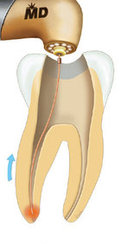
Root Canals
When it comes to visiting the dentist, there is nothing people dread more than the possibility of having to experience a root canal. In the past, root canals we known as incredibly painful procedures, but with the modern advances in dentistry, root canals no longer require you to suffer immense pain. In fact, as Missoula’s Top Rated Local® family dentist, Dr. David B. Duke utilizes dental technology that will make the root canal procedure result in little to no pain.
Laser Dentistry and Endodontics
When you are suffering from tooth pain or increased sensitivity, there is a strong chance you may have a problem with the nerves in your tooth. A root canal procedure performed at Bitterroot Dental utilizes our laser dentistry techniques to disinfect the canal and limit post-operative pain. Additionally, your tooth will heal faster which will give you a reason to smile.
Continue reading about our root canal procedure below for a more thorough explanation, or schedule an appointment today!
Root Canal

Endodontics is the dental specialty that deals with the nerves of the teeth. Root canals are probably the most notorious procedure in dentistry and the most common procedure relating to endodontics. When a tooth becomes infected it is usually related to the nerves in the root of the tooth. Generally, an infected tooth has pain or increased sensitivity to cold or biting pain. The infected nerves need to be removed. If left untreated an infection can turn into an abscess, which is a much more serious problem that includes bone loss in the jaw. In some instances, a tooth may have such significant decay that, although the tooth may not be hurting, complete removal of the decay by Dr. Duke will be impossible without damaging the nerve as the decay is simply too close to the nerve. To avoid this certain post-operative pain, it may be necessary to do a root canal. Without performing the root canal, either complete decay removal will not be possible or extreme post-operative pain will begin.
The area around the tooth is numbed with a local anesthetic to start the procedure. Dr. Duke will then drill down into the tooth to create an opening into the canal. They will then be able to remove infected tissue and clean the canal. After the infection has been removed, the space is filled with a sealant called gutta percha. It is highly recommended that a tooth that has undergone a root canal is fitted with a crown. This will provide the best seal possible to protect against future bacterial reinfection, provide stability to the tooth (remember, the center of the tooth is now hollow and the tooth’s core strength is significantly weakened), protect from future fracturing of the tooth (teeth dessicate or dry out over the years after a root canal has been performed, making them more brittle), and improve the appearance of the tooth.
“Root canal” has become a scary term for dental patients to hear, but the benefits of the procedure and advances in dental technology have made it much less “scary”. Modern techniques yield very high success rates. Local anesthetics and proper pain medication allow the procedure to be performed with little to no pain in most cases. There may be some soreness or biting pressure following the procedure. Over the counter painkillers are usually enough to relieve any pain afterwards. The procedure will also relieve you from pain caused by the infection allowing you to enjoy all the foods you love without any pain from heat, cold, or biting too hard. If you are experiencing pain consult your dentist today.
Apicoectomy (Endodontic Surgery)
An apicoectomy is performed after an unsuccessful root canal. When an infection will not go away or returns after a root canal has been performed this procedure is usually necessary. There are many nerves that may contain the infected tissue, so it is difficult to ensure that all of the infection is removed during a root canal. During an apicoectomy, the tip of the root of the tooth is removed and replaced with a filling. In most cases a second root canal (retreatment) is considered before an apicoectomy since it is a simpler, less invasive procedure.
Re-treatment
 With proper care, most teeth that have had endodontic (root canal) treatment can last as long as other natural teeth. Root canals have a 95% success rate. In some cases, however, a tooth that has received endodontic treatment fails to heal. Occasionally, the tooth becomes painful or diseased months or even years after successful treatment.
With proper care, most teeth that have had endodontic (root canal) treatment can last as long as other natural teeth. Root canals have a 95% success rate. In some cases, however, a tooth that has received endodontic treatment fails to heal. Occasionally, the tooth becomes painful or diseased months or even years after successful treatment.
Why do I need retreatment?
As occasionally happens with any dental or medical procedure, a tooth may not heal as expected after initial treatment for a variety of reasons:
- Narrow or curved canals were not treated during the initial procedure.
- Complicated canal anatomy went undetected in the first procedure.
- Difficult canal anatomy or obstruction prevented complete cleaning of the canal to the end (apex).
- The placement of the crown or other restoration was delayed following the endodontic treatment.
- The restoration did not prevent salivary contamination to the inside of the tooth.
- In other cases, a new problem can jeopardize a tooth that was successfully treated
For example:
New decay, a fractured tooth, a cracked, broken or loose filling or crown can expose the root canal filling material to bacteria, causing a new infection in the tooth. Retreatment is performed in one or two visits and involves the following:
- At the initial visit Dr. Duke will examine the tooth, take x-rays and discuss your treatment options. If you choose re-treatment, the re-treatment will be scheduled at that time for a future date. In some cases, you may be referred to an endodontist.
- At the re-treatment appointment Dr. Duket will administer local anesthetic to numb the tooth. After the tooth is numb, the tooth will be isolated using a rubber dam to prevent new bacteria from accessing the tooth while work is being performed. Dr. Duke will reopen your tooth to gain access to the root canal filling material. In many cases, complex restorative materials (crown, post and core material) must be disassembled and removed to permit access to the root canals.
- After removing the canal filling, the he can clean the canals and carefully examine the inside of your tooth using magnification, searching for any additional canals or unusual anatomy that requires treatment.
- After cleaning the canals, Dr. Duke will fill and seal the canals and place a temporary filling in the tooth. Post space may also be prepared at this time.
- After your re-treatment is complete, you will need to return as soon as possible to have a new crown or other restoration placed on the tooth to protect and restore it to full function.
- If the canals are unusually narrow or blocked, your endodontist may recommend endodontic surgery or extraction.
Cleaning the Canals
For a root canal to be successful, the harmful bacteria inside the pulp and canals must be eliminated. In our office, we take a unique approach to cleaning the canals. We combine traditional cleaning methods with laser disinfection to achieve the most clean surface possible. Using special tips designed to reach the bottom of each root, we can use low level laser light to kill stubborn and hard to reach bacteria. Simply, laser disinfection allows us to get the canals cleaner than is possible without it so your tooth will heal faster and have a smaller chance of becoming reinfected down the road.


